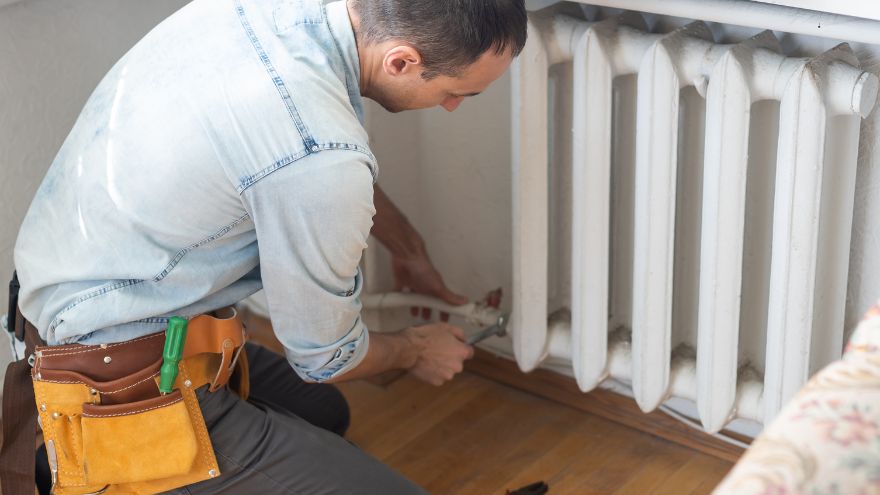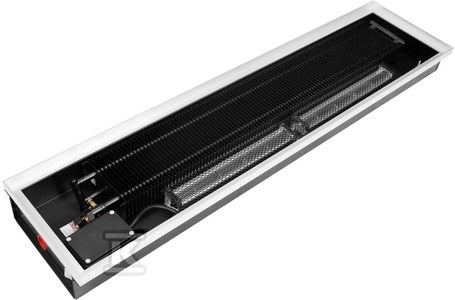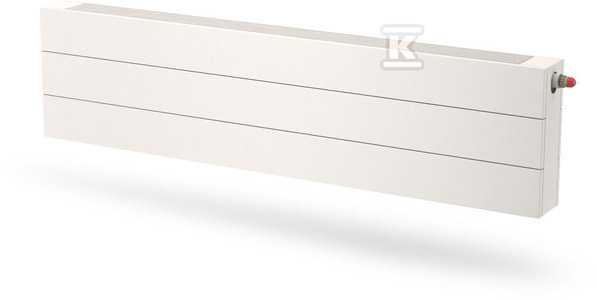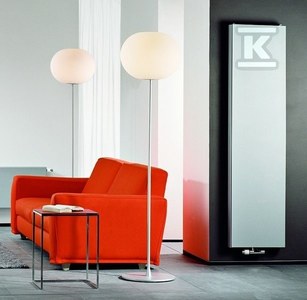The first symptoms of a heating system failure appear with the arrival of cold weather and this is not an exceptional situation. Moreover, it is not a tragedy, provided that we remain calm and systematic. Let us remember that for the correct functioning of radiators, the correlation of many factors occurring simultaneously is required, of which tightness is considered one of the basic ones. What to do when the radiator stops heating? Check what are the main reasons for cold radiators? What is radiator air lock?

Check out the radiators at the Onninen wholesaler
What if only one radiator doesn't heat?
There can be a surprising number of reasons for this phenomenon, and in many cases the failure occurs due to incorrect setting of regulators and valves.
- Reasons for lack of heating in one radiator:
- Drain valve closed;
- Damaged or incorrectly selected thermostatic valve;
- Incorrect adjustment of the initial setting in the thermostatic valve;
- Air in the radiator;
- Dirt inside the radiator;
- Leaking radiator;
- Low pressure in the heating system;
- Radiator or installation errors;
Drain valve closed
The drain valve (return valve) is usually located at the bottom of the radiator. It is used to drain water from the radiator and, in a sense, is responsible for the entire water circulation in the system. A closed valve limits the water flow, which in turn reduces the heating temperature.
After removing the masking cap, you can unscrew the valve yourself, sometimes this requires using an Allen key. This treatment makes heating functions properly again.
Damaged or incorrectly selected thermostatic valve
 Incorrect selection of the thermostatic valve may be indicated by the fact that the heating level does not correspond to the readings on the thermostat. It happens that the valve set in position "1" gives a more intense heating effect than, for example, position "3".
Incorrect selection of the thermostatic valve may be indicated by the fact that the heating level does not correspond to the readings on the thermostat. It happens that the valve set in position "1" gives a more intense heating effect than, for example, position "3".
It is slightly worse if even turning the thermostat head all the way does not result in a heated radiator. In such a situation, the needle mounted inside the thermostat is probably pressed too hard. This can be remedied by unscrewing the head and pulling out the mechanism using pliers.
Incorrect adjustment of the initial setting in the thermostatic valve
The initial setting is most often used in closed installations. It can be found under the thermostat knob. It functions as a water circulation regulator in the radiator, whereby the hot water flow is dampened or increased by changing the setting level.
Air in the radiator
This is one of the most common causes of radiator malfunction, but air lock should be treated as a natural phenomenon and not the result of a radiator fault. In practice, it can be said that all radiators are subject to this process.
Air in the radiator is the result of air entering the heating system. Open installations are particularly susceptible to this phenomenon, as the expansion vessel is in constant contact with air. Additionally, radiators become airtight due to leaks in other elements of the heating system (pipes, valves, pumps).
Dirt inside the radiator
Deposits in the form of rust or scale accumulating inside the radiator effectively interfere with the free flow of the medium. In this case, it is necessary to rinse the radiator.
Leaking radiator
Leaky valves, damaged fins or leaking connections are a few reasons that cause leaks from the heating tank and installation. In many cases, it is enough to replace the valve or seals, sometimes it is necessary to purchase and install a new radiator.
Low pressure in the heating system
Too low pressure means that hot water cannot enter the circulation. In a single-family building, it is possible to increase the pressure yourself. In multi-family buildings, the fault should be reported to the building manager, who should intervene in the heating plant.
Radiator or installation errors
If none of the above-mentioned faults occur, the reason for the radiator failure may be an error in its installation. The only solution is to reinstall the radiator, paying particular attention to the location of the drain and distribution valves.
Check out the radiators at the Onninen wholesaler
Why is the radiator cold at the bottom?
The difference between the temperature felt in the lower and upper part of the radiator is most often caused by air in the radiator. Too much air in the system lowers the water pressure level and therefore reduces the energy efficiency of the system. The reason may be damage to some parts and water leakage.
A similar situation occurs when the last radiator in the system stops heating. You should then force the water to circulate by turning the thermostat knob as far as it will go while turning off the other radiators. If the heater still does not function smoothly, it should be disassembled and flushed.
Why does only one fin heat up in the radiator?
 The situation is analogous to the one previously described. It can only be added that this happens when the power supply and return are connected to the radiator on the same side. The heating medium flows only through the fins located near the connections (supply/return) and only there the heat effect is felt. In order to check the correct operation of the installation, it is worth increasing the water flow to the maximum.
The situation is analogous to the one previously described. It can only be added that this happens when the power supply and return are connected to the radiator on the same side. The heating medium flows only through the fins located near the connections (supply/return) and only there the heat effect is felt. In order to check the correct operation of the installation, it is worth increasing the water flow to the maximum.
How to recognize that there is air in the radiator?
Air in the radiator is relatively easy to remove. The main causes of this phenomenon include:
- Air particles entering the radiator;
- Installation leakage.
- Irregularities occurring when filling the central heating system.
Relatively loud gurgling or noise may indicate that there is air in the radiator. An additional disturbing signal is uneven heating of the radiator (the upper part is cold, the lower part is warm) and a significant decrease in the thermal efficiency of the entire device.
Why doesn't the radiator heat up despite bleeding?
Most often, the radiator does not heat despite venting due to insufficient pressure of the heating medium. There is not enough water in the installation, which may be the result of leaks and leaks in the heating system elements.
To check this, you can use a pressure gauge whose pointer should stop in the area indicating the optimal number of bars. Pressure that is too low requires intervention by adding water to the system and bleeding the radiators. Residents of apartment blocks should report any faults to the building manager.
Radiators at the Onninen wholesaler
In addition to their heating functions, radiators can also be an attractive and original decoration. We will try to show you the most popular radiator models, both in terms of design and efficiency.
 It is a vertical radiator that allows the use of narrow wall surfaces, often found near windows and doors. A perfectly flat front plate, gently rounded edges and clean, straight lines match perfectly with styles based on the simplicity of forms.
It is a vertical radiator that allows the use of narrow wall surfaces, often found near windows and doors. A perfectly flat front plate, gently rounded edges and clean, straight lines match perfectly with styles based on the simplicity of forms.
Cold-rolled low-carbon FePO1 embossed sheet is exceptionally resistant to the undesirable effects of water, and its thickness makes the radiator resistant to mechanical damage.
Kos V radiators are available in 220 shades of the RAL palette, made to individual order.
The Narbonne VT horizontal decorative radiator is made of profiled steel heating elements with a rectangular cross-section connected in series. The Narbonne VT radiator is equipped with two side covers and an upper grill-type cover.
A distinguishing feature of Narbonne radiators is the lack of leaks at a pressure 1.3 times higher than the maximum working pressure (kPa), which is 1000 kPa. Additionally, there are no deformations, with a load of 1.69 times the working pressure.
The maximum permissible surface temperature is up to 120°C.
Channel heater recommended for heating rooms with numerous glazings. The QUATTROVENT heater is placed along the window line to blow warm air, eliminate the cold coming from them and prevent the windows from "sweating". Heating power 20°C – 75/65: 5139 W.
Faults in heating systems usually occur naturally and are relatively easy to fix on your own. To reduce the number of their occurrence, it is worth taking care of high-quality radiators in advance, made of proven materials.
Are you looking for the best radiators for your home or business? Check out the offer of the Onninen wholesaler today. With us you will choose radiators that meet your requirements.